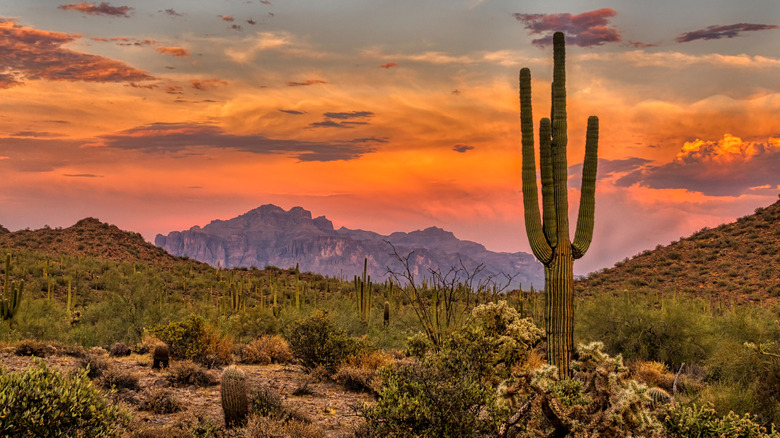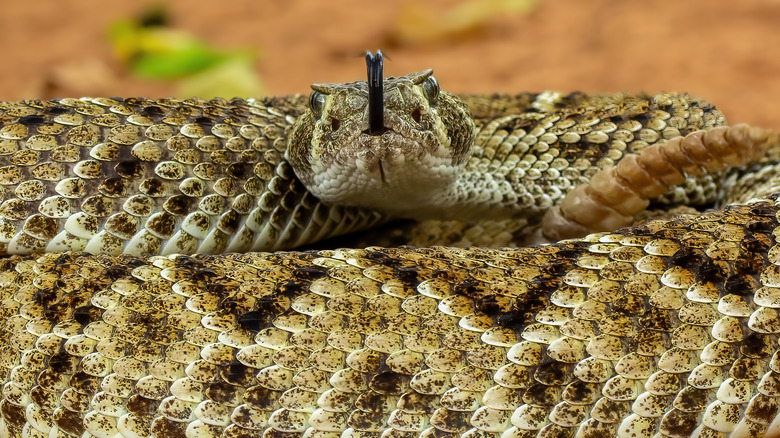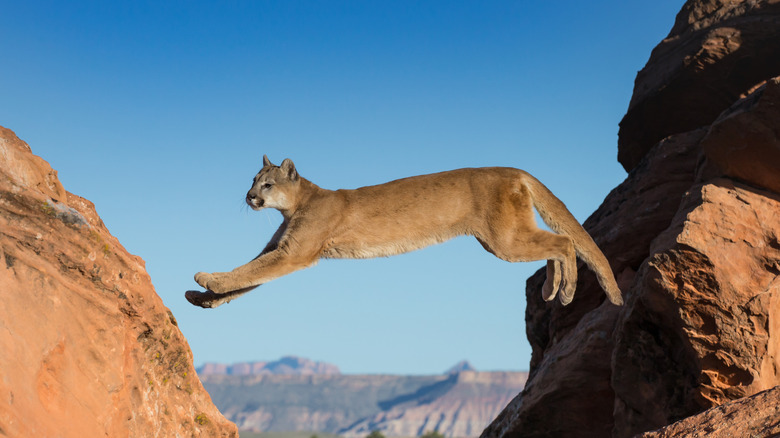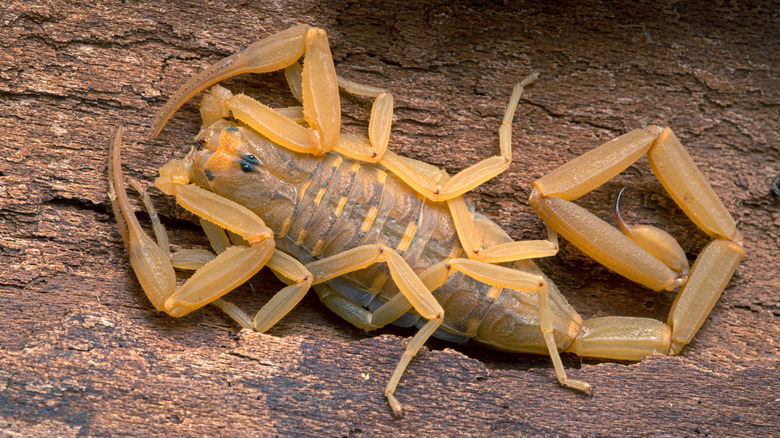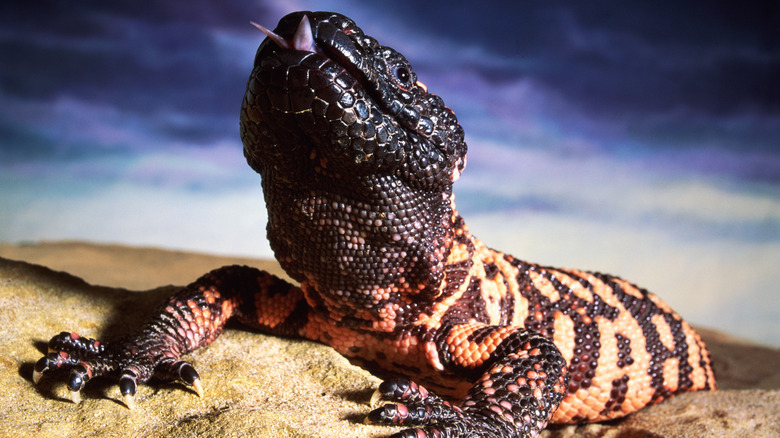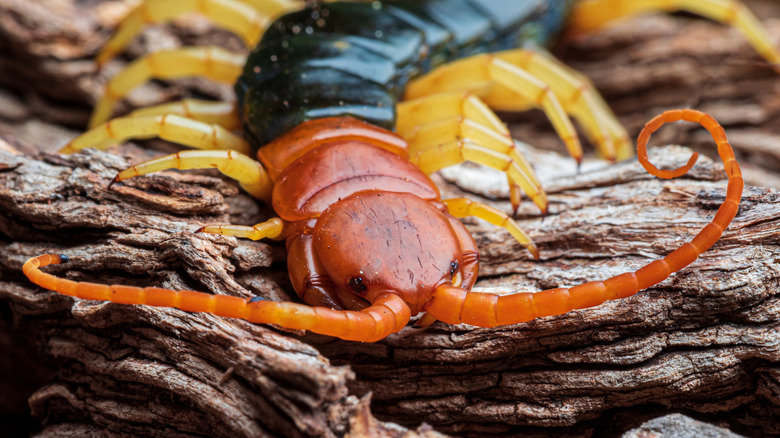5 Creatures To Beware Of When Adventuring In The Arizona Deserts
We may receive a commission on purchases made from links.
There are four major deserts in the United States. A portion of each of them — the Sonoran, Mojave, Chihuahuan, and Great Basin — are at least partially within the state of Arizona. This makes Arizona the only state in the U.S. to have four different deserts within its borders. Because of this, well over half of Arizona is either semi-arid or arid desert, meaning if you are adventuring outdoors in Arizona, you most likely will be in a desert. These deserts present a number of challenges and dangers, not the least of which are some of the creatures that live in these harsh conditions, including deadly mammals, venomous snakes, and stinging insects.
Despite the perils of adventuring in Arizona deserts, more than 45 million visitors head to the Grand Canyon State each year. Many of these visitors are heading to the natural feature which has given Arizona its nickname. Grand Canyon State Park is one of the most popular national parks in the U.S. However, it is also one of the most dangerous national parks. The fact the Grand Canyon is in a desert — actually straddling both the Sonoran and Mojave deserts – is part of the reason it is considered one of deadliest places in the country.
So, if you do decide to take a trip to the deserts in Arizona, you need to be well prepared for the harsh weather, as well as a myriad of dangerous plants and animals. Dangerous critters you may encounter include various spiders, blister beetles, and fire ants, as well as these five creatures to beware of when adventuring in Arizona deserts.
Rattlesnakes represent danger in the desert
Rattlesnakes are somewhat synonymous with desert regions. They certainly are among the more infamous of desert inhabitants. Given that such a large portion of Arizona is considered desert, it should be no surprise that more than a dozen species of rattlesnakes are found here. Among the better known species of rattlers living in Arizona are the Western Diamondback, Mojave, and sidewinder varieties.
Considering there are so many rattlers found here, you should really be familiar with what to do if you encounter a rattlesnake while adventuring in the deserts of Arizona. Of course, all rattlesnakes are venomous and considered dangerous types of snakes, so determining the type of rattler is really secondary. The main thing to remember is to give the snake plenty of space and never attempt to grab or handle it. Instead, try to back away and leave the area or allow the snake to continue on its way.
Many people who regularly spend time in the desert choose to wear protective gear such as Rocky Lynx waterproof snake boots or QOGIR snake gaiters. If you or someone in your group is bitten by a rattlesnake, be sure to avoid making mistakes in treating the wound, such as applying a tourniquet or attempting to suck out the venom. Such methods were once thought to be helpful, but have since been disproven. Instead, call 9-1-1 or the ranger station, remove any clothing or jewelry near the bite site, rinse the wound, and wrap it in a loose, wet cloth.
Mountain lions are found throughout Arizona deserts
Mountain lions are found in every desert in Arizona. Although the population of big cats in Arizona is thought to be around 2,500, odds of seeing one are fairly slim. This is because, despite their size, mountain lions tend to be timid around humans. In fact, they generally prefer to avoid areas with human activity. So, if you do come across one, it will most likely be in more remote areas of the desert. However, given that they are present and can present a considerable risk, you need to be aware of what to do if you see a mountain lion.
The best way to stay safe around mountain lions is to avoid them altogether. To do this, it helps to make noise as you move down a hiking trail or when you are in camp. This will help alert the big cat to your presence and prevent startling one. You should also be aware of your surroundings and look for warning signs a mountain lion may be near, such as scat or claw marks. Additionally, it is always safer to move with a group rather than alone. Finally, it is a good idea to carry bear spray for protection, like a canister of SABRE Frontiersman, as it can be used to prevent mountain lions and other animals from attacking as well.
If you do see a mountain lion, do not run. Try to stand tall and make yourself look as big as possible while waving your arms and speaking to the creature in a loud voice. If the cat continues to approach, throw sticks or rocks in its direction. As a last resort, discharge a cloud of bear spray if it aggressively approaches within 30 feet.
Scorpions sting thousands each year
Scorpions are common throughout the American Southwest and they are often associated with desert regions. Arizona, being largely desert, is home to as many as five dozen species of scorpions. Although pretty much every type of scorpion is capable of inflicting a painful sting, most are more of a pest, as opposed to a real danger. The exception is the Arizona bark scorpion. Unfortunately, bark scorpions are not only the most dangerous type of scorpion found in Arizona, they are also the most commonly encountered.
Bark scorpions are fairly small — typically under three inches. They also are not known to be aggressive. However, they are venomous and can deliver a sting that is both painful and dangerous. This most often happens when someone accidentally comes in contact with a scorpion while putting on boots or shoes or reaching into unseen areas.
Luckily, it's only a few of the thousands of people who are stung each year actually die. The rest suffer symptoms ranging from extreme pain and swelling to numbness, nausea, and muscle spasms. If you are stung by a scorpion, clean the wound with soap and water. Then, apply an ice pack and take an antihistamine and pain reliever. If you begin having difficulty breathing or any allergic reactions, seek medical help immediately.
Gila monsters have a harmful reputation
Gila monsters are very unique creatures. They are capable of reaching lengths of close to two feet and are one of only a handful of venomous lizards found worldwide. Although populations of gila monsters are spread across the Southwest United States, they are mostly found in Arizona. Although their venom is equivalent to that of rattlesnakes, they typically aren't a threat to humans unless they feel threatened. This is because they are relatively slow moving and spend much of their time burrowed below ground.
Although gila monsters spend the majority of their days underground, they do appear on the surface, emerging to feed and warm themselves in the desert sun. This is when they are typically encountered by humans. However, even if you stumble across one, it will most likely try moving away rather than biting. Typically, they will also hiss before biting. This is your cue to move away and leave it alone. If it still feels threatened after it's warning hiss, it will likely bite.
In addition to potent venom, gila monsters are equipped with incredibly strong jaws and often do not willingly let go of whatever they bite. As a result, if you are bitten, it may be necessary to pry the creature's jaws open with a stick. It is recommended to allow the lizard to have all four feet firmly on the ground when attempting this, as it is likely to continue biting even harder if it feels it doesn't have firm footing. Once you are freed of the lizard's grasp, keep the wound below heart level and seek medical attention. Do not put ice or cold packs on the wound. You also should not cover it with a constrictive bandage or utilize a tourniquet.
Giant desert centipedes can deliver painful bites
Another unique creature found in the Arizona desert, the giant desert centipede, looks somewhat otherworldly. Reaching lengths up to eight inches long, this large centipede is a proficient predator that feeds not only on insects, but also small reptiles such as frogs and lizards, as well as mice and other rodents. They are able to immobilize these larger creatures with a fairly potent venom.
Like gila monsters, giant centipedes spend the majority of their time underground or hidden beneath rocks or logs. However, humans do encounter them. If you do come across one, do not attempt to pick it up or handle it. If you do, you run the risk of being bitten and injected with this toxin yourself. While the venom of a giant centipede is not lethal to humans, their bites can be very painful and cause swelling, headaches, and nausea.
If you do happen to be bitten by a giant desert centipede, wash the area thoroughly. Then, apply ice or cold packs to help prevent or reduce swelling. You may also want to take an over-the-counter antihistamine and pain killer. If the pain becomes too intense or you begin having an allergic reaction, seek medical help.
